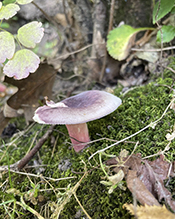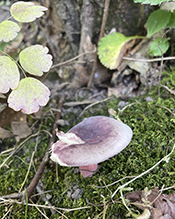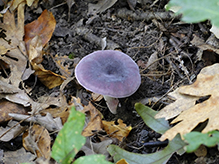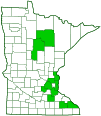Purple-bloom Russula
(Russula mariae)
Conservation • Description • Habitat • Ecology • Distribution • Taxonomy
Conservation Status |
|
|||||||
| IUCN Red List | not listed |
|||||||
| NatureServe | not listed |
|||||||
| Minnesota | not listed |
|||||||
Description |
||
Purple-bloom Russula is a medium-sized brittlegill mushroom. It is common and widespread in deciduous and mixed woodlands and forests of North America east of the Rocky Mountains. It is found from June through October, singly or in groups, on the ground near hardwoods, especially oaks. It obtains its nutrients from the rootlets of oak and other hardwood trees (mycorrhizal). The cap is convex when young. As it ages it flattens and sometimes develops a shallow depression at the center. It is ¾″ to 2 ¾″ in diameter, sometimes larger. The color is variable. It is usually purple but may also be purplish-red, reddish, pinkish, olive, yellow, or brown. It is sometimes mottled with two or more of these shades. It is covered with a fine white powder (bloom) giving it a velvety or powdery appearance. The skin on at least the outer half of the cap peels away easily. On mature caps the margin is sometimes narrowly grooved (striate) near the margin. The gills are white at first, turning cream-colored to pale yellow with age. They are closely spaced and are broadly to narrowly attached to the stalk. The margins are sometimes colored due to contact with the stalk when the mushroom was developing. The stalk is ¾″ to 3″ long and ⅜″ to 1″ in diameter. It is firm, fairly smooth, white, and often tinged with purple or red. The bottom is the same size or slightly wider than the top. The flesh is thin, brittle, and white. It does not change color when sliced. It is edible but not pleasant. The spore print is creamy white to pale yellow. |
||
Similar Species |
||
Habitat and Hosts |
||
Hardwood and mixed forests and woodlands |
||
Ecology |
||
Season |
||
|
||
Distribution |
||||
|
Sources |
|||
| 8/21/2022 | ||||
Occurrence |
||||
Common and widely distributed east of the Rocky Mountains, uncommon im Minnesota. |
||||
Taxonomy |
|||
| Kingdom | Fungi (Fungi) | ||
| Subkingdom | Dikarya | ||
| Phylum | Basidiomycota (Basidiomycete Fungi) | ||
| Subphylum | Agaricomycotina (Higher Basidiomycetes) | ||
| Class | Agaricomycetes (Mushrooms, Bracket Fungi, Puffballs, and Allies) | ||
| Subclass | Agaricomycetidae | ||
| Order | Russulales | ||
| Family | Russulaceae (milkcaps, brittlegills, and allies) | ||
Genus |
Russula (brittlegills) | ||
| Subgenus | Heterophyllidia | ||
| Subsection | Amoeninae | ||
Synonyms |
|||
| Russula alachuana | |||
Common Names |
|||
Powdered Russula Purple-bloom Russula |
|||
Glossary
Mycorrhizal
A symbiotic, usually beneficial relationship between a fungus and the tiny rootlets of a plant, usually a tree.
Striate
Striped or grooved in parallel lines (striae).
Visitor Photos |
|||||
Share your photo of this fungus. |
|||||
| This button not working for you? Simply email us at info@MinnesotaSeasons.com. Attach one or more photos and, if you like, a caption. |
|||||
Honey Fae (Farah) |
|||||
 |
 |
||||
Kirk Nelson |
|||||
Russula mariae, Lebanon Hills Regional Park |
|||||
 |
|||||
MinnesotaSeasons.com Photos |
|||||
|
|||||

Slideshows |
||

Visitor Videos |
|||
Share your video of this mammal. |
|||
| This button not working for you? Simply email us at info@MinnesotaSeasons.com. Attach a video, a YouTube link, or a cloud storage link. |
|||
Other Videos |
|||

Visitor Sightings |
|||||
Report a sighting of this fungus. |
|||||
| This button not working for you? Simply email us at info@MinnesotaSeasons.com. Be sure to include a location. |
|||||
| Honey Fae (Farah) 9/2/2022 |
Location: Dakota County |
||||
| dpcollyds 8/21/2022 |
Location: Hibbing, Mn |
||||
| Kirk Nelson 9/23/2017 |
Location: Lebanon Hills Regional Park |
||||
MinnesotaSeasons.com Sightings |
|||||
|
|||||

Created: 7/21/2018
Last Updated:


